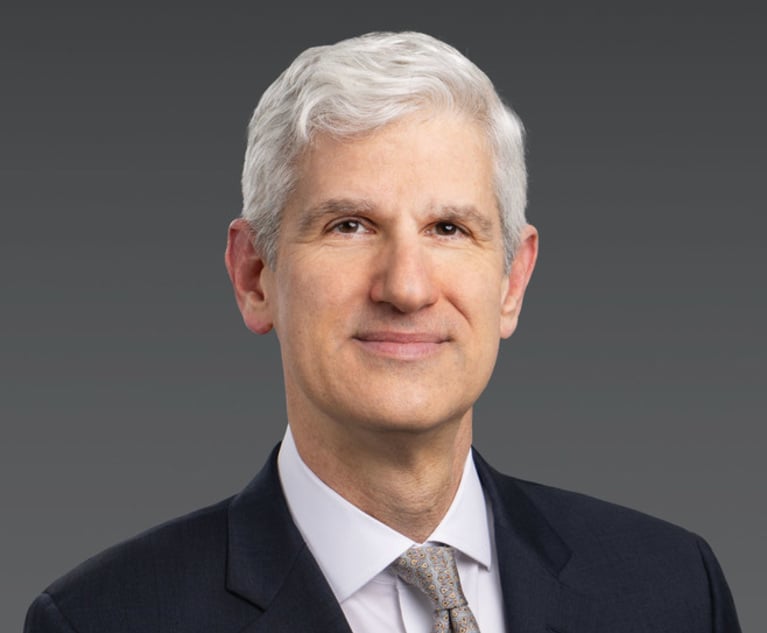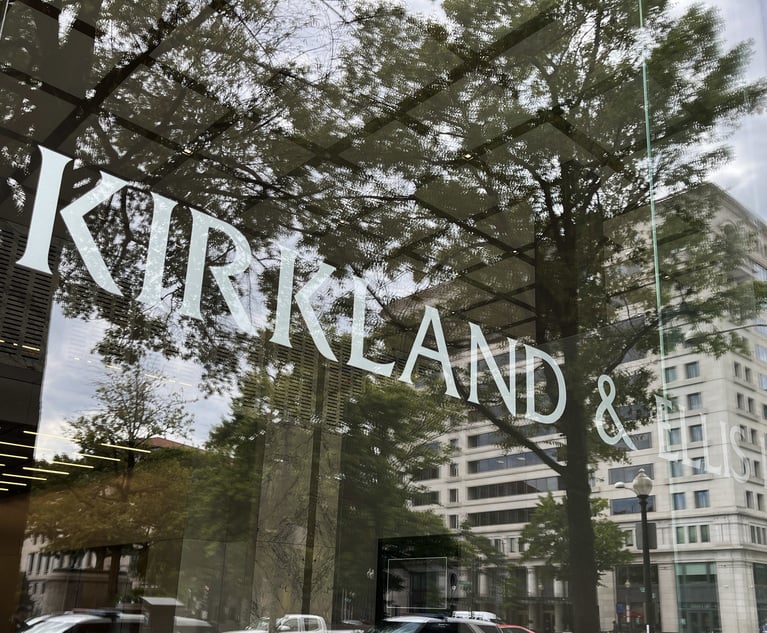How a Law Firm's Comp System Affects Profitability and Partner Satisfaction
Profitability growth has varied markedly by compensation system over the past decade, while partner satisfaction has been consistent across all systems. The choice of compensation system is thus best thought of as a critical strategy decision.
April 21, 2020 at 09:25 AM
7 minute read
 Credit: Kevin Fales
Credit: Kevin Fales
Compensation systems are typically a strategic afterthought, seen as the means by which to allocate the spoils of a successful strategy. They're viewed as affecting the level of grousing among partners, but not a firm's performance. The data, however, indicates the reverse is true. Profitability growth has varied markedly by compensation system over the past decade, while partner satisfaction has been consistent across all systems. The choice of compensation system is thus best thought of as a critical strategy decision, with second-order implications that leaders need to think through and manage adroitly.
Let's start with the data. It comes from the biennial Major, Lindsey & Africa Partner Compensation Surveys of 2012 through 2018 and comprises 4,266 data points for U.S.-based equity partners. Firm profitability, a direct counterpart of partner compensation, has been on differing trajectories depending on the system—growing strongly at lockstep and open-system firms (those non-lockstep firms in which partners know or can easily learn what their colleagues earn), while plateauing at closed-system firms (those non-lockstep firms in which partners don't see each other's salaries). Partner hours and billing rates vary modestly across the different systems, but average originations diverge strongly, with those at closed-system firms being both appreciably lower and on a weaker trajectory.
Infographic design by Roberto Jiménez/ALM
A logical explanation for performance at closed-system firms is that partners' competitiveness and animal spirits are dampened by not seeing what everyone earns, and that they are therefore less inclined to hustle. The data shows there's a subtlety to this: It's not that partners at closed firms are working less than those at open-system firms—their average billed hours are actually the same—but that they sell less work (average originations lag by 19% over the time period) and they operate at lower leverage (an average of 1.9 versus 2.9). It's consistent with the credible notion that, absent countervailing pressures, lawyers will be drawn more to substantive legal work than to developing client relationships or managing others.
It's natural to suspect the strength of lockstep firm performance has to do with the power of the Wall Street elite who follow such systems. This is probably having only a modest effect here, as the billing rates of the lockstep firm partners in the data set are little different from those at other firms. Another possible explanation is that lockstep fosters a higher-performance esprit de corps among partners. Maybe. It may also be that lockstep firms are more cautious about equity partnership, promoting only those who are inveterate hard chargers.
I can't help feeling that a piece of the explanation is more structural, particularly having to do with the breadth of service lines offered by the 14% of firms that are still lockstep. Specifically, lockstep firms tend to have relatively narrow breadth of service offerings. It became too hard for broadline firms, with the consequent wide range in the economics of different partners' practices, to stay lockstep. Indeed, some lockstep firms have shed low-profitability ancillary service lines to help preserve lockstep. As a result, lockstep firm performance has not been dragged down by the ill-conceived geographic and product line expansions that proved alluring to other types of firm.
So, should more firms be lockstep? Probably not. Apart from the toothpaste-is-out-of-the-tube dynamic of trying to get partners to go along with it, it's a system with a fundamental flaw: the potential for large, sustained disconnects between economic contribution and compensation. This disconnect risks having highly productive partners be picked off by rivals. What keeps partners from leaving is often their bond with fellow partners. This is a strong but brittle tie. Once one leaves, it's easier for the next, and then the next again. The unraveling of a partnership takes much longer to start than anyone expects, and then happens more quickly than anyone ever imagined possible.
For firms that are lockstep there is one compelling argument for remaining so: It has distinct appeal to a segment of highly desirable partners, particularly those already at the firm, who would see little advantage in being just another open firm. Rather than abandoning lockstep, there are many tweaks a lockstep firm can employ to mitigate the potential disconnect between contribution and compensation: expanding (perhaps dramatically) the number of partners on nonequity tracks; allowing longer periods, and flexibility in time spent, at a given level; placing a cap on the lockstep level to which partners in support practices can ascend; allowing compensation committees the ability to move partners down the ladder; uncapping the system for more types of partners, such as desirable laterals; varying lockstep ladders by country (a near necessity) and cities (worth considering); and introducing or expanding the ranks of "local" or "country" partners.
It's hard not to feel that partners at closed-system firms are hard done by. They make an implicit trade-off: We'll do less of the stuff we don't like (selling, operating at leverage) and sacrifice the attendant financial upside, but in exchange we'll get to work in a low-griping, low-snarking and all-around more professionally satisfying environment. The former part of the trade-off has proven real, the latter elusive. In looking at how satisfied equity partners are with their lives as attorneys, without factoring compensation into the equation—the second part of the trade-off—there is no meaningful difference by firm type. In each case, just over 70% of partner say they are either slightly, moderately or very satisfied.
If you are inclined to feel sorry for partners at closed-system firms, perhaps feel particularly so for junior partners (those up to 10 years as a partner in this analysis). While the compensation trajectories of junior and senior partners at lockstep and open firms have followed similar paths, those of partners at closed firms have uncoupled. Junior partners at closed-system firms, once compensated roughly the same as their counterparts at open and lockstep firms, are now making 30% to 40% less.
Infographic design by Roberto Jiménez/ALM
Should more closed-system firms go open? Well, probably not. Just as for lockstep, being closed has distinct appeal to a segment of partners, particularly those already at the firm, who would see little advantage in being just another open firm.
So what levers might leaders at closed-system firms look to pull? On improving profitability, tactics could include less focus on billed hours and more focus on revenues sourced or managed and on leverage. Firms may consider going partially open—letting partners know ranges of compensation but not how much each individual makes. The data shows firms with such systems do not incur the closed-system profitability shortfall. Closed-system firm leaders could also contemplate the notion that visibility on compensation outcomes is entirely separate from clarity on how compensation is determined. Explaining the influence of originations and leverage on compensation may motivate some partners to evolve to more profitable ways of practicing.
Hugh A. Simons is formerly a senior partner and executive committee member at The Boston Consulting Group and chief operating officer and policy committee member at Ropes & Gray. Contact him at [email protected].
This content has been archived. It is available through our partners, LexisNexis® and Bloomberg Law.
To view this content, please continue to their sites.
Not a Lexis Subscriber?
Subscribe Now
Not a Bloomberg Law Subscriber?
Subscribe Now
NOT FOR REPRINT
© 2025 ALM Global, LLC, All Rights Reserved. Request academic re-use from www.copyright.com. All other uses, submit a request to [email protected]. For more information visit Asset & Logo Licensing.
You Might Like
View All
Paul Hastings, Recruiting From Davis Polk, Adds Capital Markets Attorney
3 minute read
Kirkland Is Entering a New Market. Will Its Rates Get a Warm Welcome?
5 minute read

Goodwin Procter Relocates to Renewable-Powered Office in San Francisco’s Financial District
Law Firms Mentioned
Trending Stories
Who Got The Work
J. Brugh Lower of Gibbons has entered an appearance for industrial equipment supplier Devco Corporation in a pending trademark infringement lawsuit. The suit, accusing the defendant of selling knock-off Graco products, was filed Dec. 18 in New Jersey District Court by Rivkin Radler on behalf of Graco Inc. and Graco Minnesota. The case, assigned to U.S. District Judge Zahid N. Quraishi, is 3:24-cv-11294, Graco Inc. et al v. Devco Corporation.
Who Got The Work
Rebecca Maller-Stein and Kent A. Yalowitz of Arnold & Porter Kaye Scholer have entered their appearances for Hanaco Venture Capital and its executives, Lior Prosor and David Frankel, in a pending securities lawsuit. The action, filed on Dec. 24 in New York Southern District Court by Zell, Aron & Co. on behalf of Goldeneye Advisors, accuses the defendants of negligently and fraudulently managing the plaintiff's $1 million investment. The case, assigned to U.S. District Judge Vernon S. Broderick, is 1:24-cv-09918, Goldeneye Advisors, LLC v. Hanaco Venture Capital, Ltd. et al.
Who Got The Work
Attorneys from A&O Shearman has stepped in as defense counsel for Toronto-Dominion Bank and other defendants in a pending securities class action. The suit, filed Dec. 11 in New York Southern District Court by Bleichmar Fonti & Auld, accuses the defendants of concealing the bank's 'pervasive' deficiencies in regards to its compliance with the Bank Secrecy Act and the quality of its anti-money laundering controls. The case, assigned to U.S. District Judge Arun Subramanian, is 1:24-cv-09445, Gonzalez v. The Toronto-Dominion Bank et al.
Who Got The Work
Crown Castle International, a Pennsylvania company providing shared communications infrastructure, has turned to Luke D. Wolf of Gordon Rees Scully Mansukhani to fend off a pending breach-of-contract lawsuit. The court action, filed Nov. 25 in Michigan Eastern District Court by Hooper Hathaway PC on behalf of The Town Residences LLC, accuses Crown Castle of failing to transfer approximately $30,000 in utility payments from T-Mobile in breach of a roof-top lease and assignment agreement. The case, assigned to U.S. District Judge Susan K. Declercq, is 2:24-cv-13131, The Town Residences LLC v. T-Mobile US, Inc. et al.
Who Got The Work
Wilfred P. Coronato and Daniel M. Schwartz of McCarter & English have stepped in as defense counsel to Electrolux Home Products Inc. in a pending product liability lawsuit. The court action, filed Nov. 26 in New York Eastern District Court by Poulos Lopiccolo PC and Nagel Rice LLP on behalf of David Stern, alleges that the defendant's refrigerators’ drawers and shelving repeatedly break and fall apart within months after purchase. The case, assigned to U.S. District Judge Joan M. Azrack, is 2:24-cv-08204, Stern v. Electrolux Home Products, Inc.
Featured Firms
Law Offices of Gary Martin Hays & Associates, P.C.
(470) 294-1674
Law Offices of Mark E. Salomone
(857) 444-6468
Smith & Hassler
(713) 739-1250









